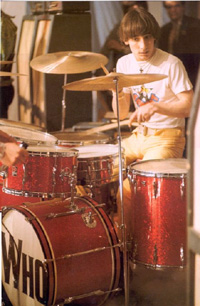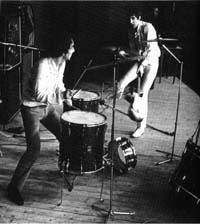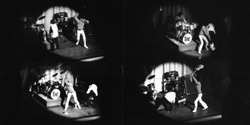Keith Moon’s Drumkits: 1966 Premier double-bass kit
1966 Premier double-bass kit details
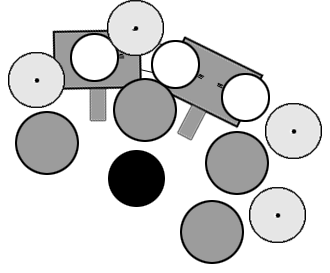
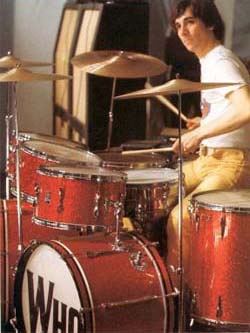
In June 1966, Moon switches to a larger Premier Red Sparkle set, featuring two bass drums locked together with tom mounts. The first known gigs for this kit are the Swedish tour of June 1966. The kit initially featured two 14″ × 8″ tom toms, later switching to three, with the third tom first appearing in July 1966.
The third floor tom — set up on his left — usually used for for setlists, drumsticks, drinks and towels, also appeared concurrent with the third tom tom in July 1966.
Timeline
- Likely first date used:
- 2 June 1966 – Gröna Lund, Stockholm, Sweden.
- Likely last date used:
- 12 June 1967 – Christ Church College Ball, Cambridge, UK.
Following the Premier double-bass kit, Keith would use a hired Slingerland kit for the remainder of June USA dates, including Monterey Pop Festival, 18 June, 1967, before using the Pictures of Lily Premier kit, beginning July 1967.
Specification
Drums:
Premier red sparkle kit (in birch), delivered May/June 1966.
- Two 22″ bass drums (locked together at the sides with two Premier tom mounts)
- Three floor toms, including 16″ × 16″ and often one 20″ × 16″
- Three 14″ × 8″ toms
- 14″ × 5½″ “2000” metal shell snare drum
Cymbals:
Paiste and Zildjian
- One 14″ or 15″ hi-hat (usually not used on stage)
- Two 16″ crash
- One 20″ ride
Drumskins
Keith, at times, used Ludwig heads on this kit.
Hardware
The variations of double kit through its use up to the Pictures of Lily kit demonstrate how Premier were advancing in building hardware to withstand Keith’s abuse.
-
Claws on bass drums:
The earlier claws are the scalloped type and the tension rods are the tapered ones with the little ball on the end. The later claws, which are the same as the Pictures of Lily kit, also use more squared-off tension rods.
-
Cymbal stands:
The cymbal stands have changed very slightly from being three flush-base Premier stands to two flush-base Premier stand and one flush-base stand with a boom attachment. For the Pictures of Lily kit, all three stands were the boom type but still flush base.
The early Premier stand that was around before the Lokfast type; Lokfast having the oval bottom tube whereas the flush base meaning flush to the floor or flat to the floor they had a cylindrical bottom tube and much thinner legs. Flush-based stands have adjustable legs, whereas Lokfast don’t.
It wasn’t until the chrome kit came along that he started to use the Lokfast type stand with boom fitments.
-
Bass drum fitments
The fitments that hold the bass drums together are the same on the red sparkle kits as on the Pictures of Lily kits: the old type Premier tom holders (possibly called “disappearing tom holders”).
-
Holders
The later version red sparkle has no additional Swiv-o-matic holders on it like the earlier one did for the cymbals. Also the display heads where both different too with The Who in a different script.
Keith used the Swiv-o-matic cymbal holders on the banks of the Serpentine when they filmed The Kids Are Alright promo film and a few other occasions. He was missing a badge off one of the 14″×8″ toms, too. The one on his right, which doesn’t have any damper. It appears to have been removed because it looks like the drum has been damaged and had to have the Swiv-o-matic bracket moved to a different position. Probably where the badge used to be. In my photo you can see the badges are as they where originally in there damaged state (they where held on with tape for the photo) the 14″×8″ tom on Keith’s left was upside down with the badge turned around making the badge lower than standard one would be. And the bass drum head on the left had a hole in it between the W & H and it looks like someone has tried to cover it inside with card or something.
-
Floor toms
All floor toms up until the chrome kit were pre-international. This was the name given to the sizes that Premier used before standardisation so the floor toms were 16¼″ across rather than 16″ before about 1966. The 12″ tom toms were a pre-international size, too.
With the early-style “beer barrel” (very stubby hole surrounds!) cast alloy rims, the later rims (chrome kit onwards) had much smoother curve around the holes. The Premier badges up until the chrome kit were edged in silver then after that all black.
The double bass drum
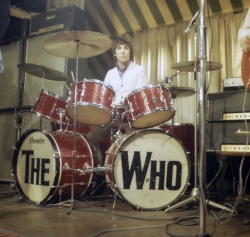
Click to view larger version. 2 March 1967, Marquee Club, London, with three toms. (Photo: SoundCityChris)
The first big drummers who used two bass drums were Louis Bellson and Sam Woodyard, who both played with the Duke Ellington Orchestra in the ’50s and ’60s.
A likely inspiration for Keith’s switch to twin bass drums was the London-born big band leader Eric Delaney — he went twin bass a good 10–15 years before Ginger Baker et al, and, as mentioned in Dear Boy, Keith used to watch Eric on telly long before the days of the High Numbers. (Eric, incidentally, turned 81 in May 2005 and still playing nearly every night of the year.)
But there were two other drummers who brought the double bass-drum kit forth in Rock and Roll: Keith Moon and Ginger Baker of Cream.
Who came first?
Some say that Baker got the idea first, then told Keith in conversation what he had ordered from Ludwig. Keith acted quickly and put two kits together, in order to first in this “drummers arms race.” However, according to Keith’s biography, Dear Boy: The Life of Keith Moon, by Tony Fletcher, the story is as follows:
Keith met drummer Phil Wainman, in early 1966, in Marshall’s music shop in Hanwell, London, a place where professional musicians met and shared experiences. Wainman was a successful session drummer, who had a double bass drumkit. Moon may have gotten the idea from him then, but it wasn’t until The Who were on a UK tour in April, with the Jimmy Cliff Sound and Phil Wainman on drums, that Moon made the first step. Moon didn’t like that a drummer in a supporting act was playing on a drumkit bigger that his. This was the first time that Moon had ever been upstaged by another drummer. Moon tried to borrow Wainman’s kit, but he refused, after seeing what Moon had done to his own kit. Moon eventually persuaded Wainman to lend him the left side of his kit, which Wainman got back in one piece.
As soon as the tour ended, Moon got Premier to make him a custom kit. It would still have the same red sparkle finish and sizes. The only custom thing about the kit though, was that the bass drums were joined together with Premier tom mounts.
It’s a fact that the bass drums were joined together, as pictures clearly show. This means that Moon didn’t simply just put two kits together to beat Ginger Baker in being first.
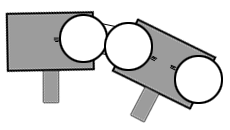
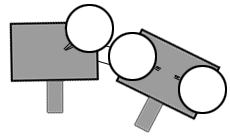
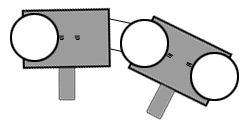
Three possible scenarios depicting problem of third tom mount setup.
The exact date that Moon first played his double bass drumkit live is unknown. According to the book Anyway, Anyhow, Anywhere, by Andy Neill and Matt Kent, the début took place at South Pier, Blackpool on 28 May 1966. “Irish” Jack Lyons remembers it as being at the first concert on a tour to Scandinavia that started on 2 June 1966. Either way, it is certain that as of 2 June, Keith Moon would never be upstaged by another drummer again.
Two or three toms
This “new” kit featured only two mounted toms, from its début at least until the British television show, “A Whole Scene Going On!” on 15 June 1966. By the time The Who filmed a promotional video for “The Kids Are Alright” in Hyde Park sometime in July, Moon had his third mounted tom in place.

Click to view larger version. Closeup of Pictures of Lily kit showing custom third tom mount, right, compared to original dual mounts, left.
Why Moon got his classic triple tom tom setup a month later than the double bass drum setup is unknown. Moon might not have known what he wanted beside the two bassdrums, so he just went on with the two mounted toms. Or, that Ginger Baker’s double bass-drum kit had only two mounted toms as well may have been the impetus for Keith to go further yet with his new kit.
There is a problem concerning the mounting of the third tom to his left. In order to have an equal amount of space between the three toms, to obtain the best “look” for the kit, the mount on the bassdrum has to be in another spot. The two tom toms to the right would be too close together. (See theoretical sketches at right, which demonstrate how the third tom could have placed using the original mounting, none of which would have been the best solution. This might have been the reason for Moon not using the three toms when he first got the two bass drums.)
This problem was solved with a custom-made third tom mount, which was placed down lower down on the kick drum than the others. (See the Premier ad, below, and Pictures of Lily kit, left).
Selected quotes
All quotes and references are copyright their original owners and are included for reference only.
Excerpt from Melody Maker, September 1966
His drum kit is about to be changed, and in the near future he will be heard playing on two 14 by 9 inch tom toms; two 16 by 20 inch tom toms; metal shell 14 by 5½ inch snare drum; 22 by 115 bass drum; 20 and 18 inch cymbals and a pair of 15 inch hi-hat cymbals.
Photo Gallery
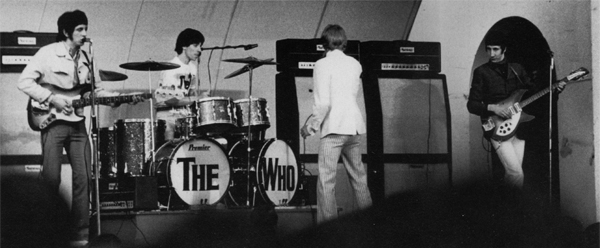
2 June 1966, Grona Lund, Stockholm, Sweden, first known use of the Premier double-bass drum kit.
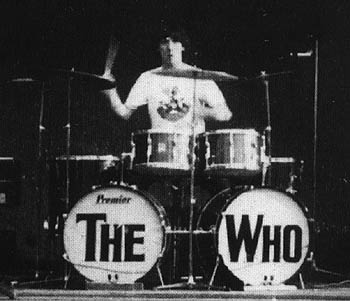
4 June 1966, Berget, Sweden, initial double bass drum kit setup, with two 14″ × 8″ tom toms and tom mounts connecting the bass drums.
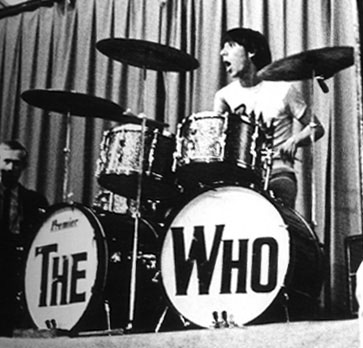
7 June 1966, initial double bass drum kit setup, with two 14″ × 8″ tom toms.
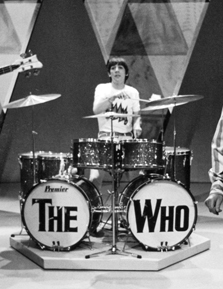
14 June 1966, on BBC, initial double bass drum kit setup, with two 14×8 tom toms and tom mounts connecting the bass drums.
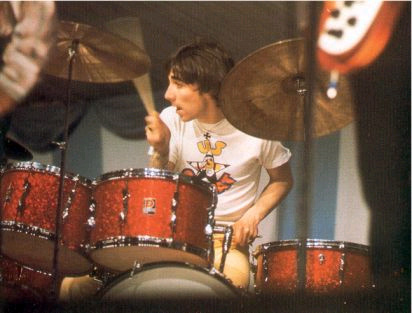
30 June 1966, Windsor Festival, note how the bass drum at right is tilted, allowing the tom mount to be placed in a manner for the tom fit to the setup.
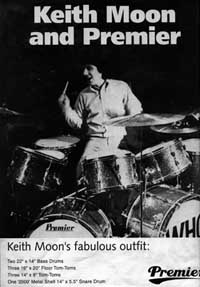
“Keith Moon’s fabulous outfit.” Premier ad, ca. 1966/67; showing custom offset mount for the third tom.
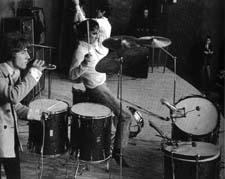
Click to view larger version. 7 May 1967, Kristianstad, Sweden, view of Premier flush stands and Premier 250 bass pedals.
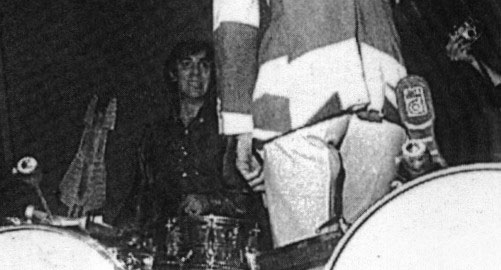
Ca. 1966, Sweden, upended bass drums from Premier kit, with 250S pedal, left, and 250 pedal, right.
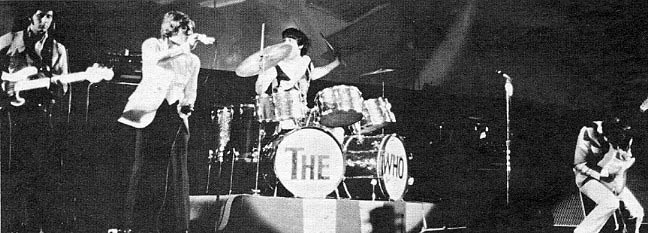
March/April 1967, the first U.S. dates: the Murray the K shows in New York.
Resources and Information
Contributors:
Many thanks to the following, who have made this page possible:
- Martin Forsbom (forsbom@gmail.com)
- Brad Rodgers at whocollection.com.
- Huw Owens (huw.owens@ntlworld.com)
- Trevor Penn
- Andy Valentine
Additional information:
- Brad Rodgers at whocollection.com.
- David Brewis at Rock Stars Guitars, for pictures of Moon’s drumsticks, timbales, claves and drumheads.
- Tam Rankin at vintprem.moonfruit.com for information on vintage Premier drums.
Bibliography:
- Drums & Drumming magazine, October/November 1989.
- Modern Drummer, September 2003.
- Moon, the Life and Death of a Rock Legend, by Tony Fletcher. 1999.
Manufacturers’ sites
- Premier Drums: premier-percussion.com
- Ludwig Drums: ludwig-drums.com
- Paiste Cymbals: paiste.com
- Zildjian Cymbals: zildjian.com
- Slingerland Drums: slingerland.com (now owned by Gibson)
- Vistalites Drums: vistalites.com
- Zickos Drums: zickosdrums.com
